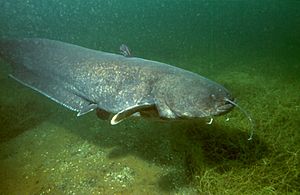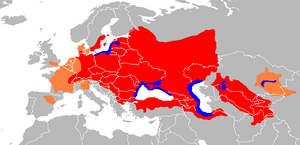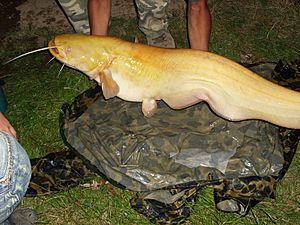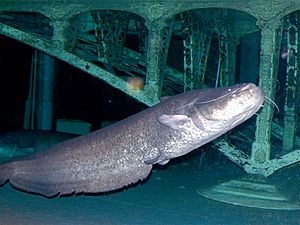Wels catfish facts for kids
Quick facts for kids Wels catfish |
|
|---|---|
 |
|
| Conservation status | |
| Scientific classification | |
 |
|
| Range of the wels catfish. Red: native occurrence. Blue: occurrence in coastal waters. Orange: introduced |
The wels catfish (Silurus glanis), also known as sheatfish, is a very large type of catfish. It naturally lives in many parts of central, southern, and eastern Europe, including areas around the Baltic, Black, and Caspian Seas. People have also brought it to Western Europe because it's a popular sport fish. You can now find it from the United Kingdom all the way to Kazakhstan and China, and south to Greece and Turkey. This freshwater fish is easy to spot with its wide, flat head and big mouth. Wels catfish can live for more than fifty years!
Contents
Where Does the Wels Catfish Live?
The wels catfish likes to live in big, warm lakes and deep rivers where the water moves slowly. It often hides in safe spots like holes in the riverbed or around sunken trees. It finds its food in open water or in deeper areas. Sometimes, wels catfish are raised in fish ponds to be used as food.
There's a special place where these fish live: inside the Chernobyl exclusion zone. A small group of wels catfish lives in old cooling ponds and channels near the power plant that is no longer used. These catfish look healthy and are important predators in the water there. They grow big because there are no humans fishing for them, and tourists sometimes feed them.
What Do Wels Catfish Eat?
Like many fish that live near the bottom of freshwater, the wels catfish eats worms, snails, insects, crabs, and other fish. Bigger wels catfish have been seen eating frogs, mice, rats, and even water birds like ducks. They can also eat other wels catfish!
Scientists in France once saw wels catfish jumping out of the water to catch pigeons on land. This was in a place where the catfish were not originally from. About 28% of the times they tried, they successfully caught a bird. This shows how adaptable these fish are. They learned new ways to find food in their new home, the Tarn River, because this behavior isn't usually seen where they naturally live. In the fall, river wels catfish might also eat red worms.
Wels catfish have also been seen eating dead Asian clams floating on the water during the day. This is interesting because they usually eat at night from the bottom. It shows they can quickly switch to new food sources when they appear.
What Does a Wels Catfish Look Like?
The wels catfish has many small teeth inside its mouth. It has two long whiskers, called barbels, on its upper jaw and four shorter ones on its lower jaw. It has a long fin on its underside, called an anal fin, which reaches its tail fin. It also has a small, sharp fin on its back, called a dorsal fin, located closer to its head.
Wels catfish use their excellent hearing and sense of smell to hunt. They also have special eyes that help them see well at night, which is when they are most active. They use their sharp side fins, called pectoral fins, to create swirling water. This confuses their prey, which the catfish then sucks into its mouth and swallows whole.
Their skin is very slimy. The color of their skin changes depending on where they live. In clear water, they might be black, while in muddy water, they are often green-brown. Their belly is always light yellow to white. Sometimes, you can even find white or albino wels catfish. Wels catfish swim like eels, and they can even swim backward!
How Big Can Wels Catfish Get?
The wels catfish is the largest true freshwater fish in Europe and parts of Asia. It can grow up to 5 m (16 ft) long and weigh over 300 kg (660 lb). However, fish this big are extremely rare today. There are old stories from the 1800s about wels catfish reaching these huge sizes. For example, some reports from the Danube river mentioned fish 3 m (9.8 ft) long and weighing 200–250 kg (440–550 lb).
Most adult wels catfish are about 1.3–1.6 m (4 ft 3 in – 5 ft 3 in) long. Fish longer than 2 m (6 ft 7 in) are not common. A wels catfish that is 1.5 m (4 ft 11 in) long might weigh 15–20 kg (33–44 lb). A 2.2 m (7 ft 3 in) long fish could weigh 65 kg (143 lb).
Wels catfish can grow to be very large if they have excellent living conditions. For example, a record wels catfish in Germany was 2.49 m (8 ft 2 in) long and weighed 89 kg (196 lb). Even larger ones have been caught in places like Poland, Ukraine, Russia, Kazakhstan, France, Spain, Italy, Serbia, and Greece. The largest accurately recorded weight was 144 kg (317 lb) for a 2.78 m (9 ft 1 in) long fish from Italy.
Wels Catfish as an Introduced Species
When wels catfish are brought to new places where they don't naturally live, it can cause problems for other fish. In some areas, after wels catfish were introduced, the numbers of other fish species dropped a lot. For example, in the Ebro river basin in Spain, some native fish have disappeared because the wels catfish compete with them for food and eat them. The river's environment has also changed, with more water plants growing.
Reproduction and Life Cycle
A female wels catfish can lay up to 30,000 eggs for every kilogram of her body weight. The male wels catfish stays and guards the nest until the eggs hatch. This can take anywhere from three to ten days, depending on how warm the water is. If the water level drops too much, the male has been seen splashing water on the eggs with his tail to keep them wet.
Wels Catfish as Food
Only the meat from younger wels catfish is good to eat. It tastes best when the fish weighs less than 15 kg (33 lb). If the fish is larger than this, its meat can be very fatty and might contain harmful substances. This is because wels catfish are at the top of the food chain, so they can collect these substances over time. Large wels catfish are not usually eaten, but they are very popular for sport fishing because they put up a strong fight.
Conservation Status
Even though the wels catfish is not considered endangered worldwide, its status can be different in various places where it lives naturally. In the northern parts of its range, its numbers have gone down over the last few centuries. It disappeared from Denmark in the 1700s and from Finland in the 1800s. In Sweden, it only lives in a few lakes and rivers and is now considered "near threatened." Studies have shown that the wels catfish in Sweden have low genetic diversity, meaning they are not very varied genetically, and are isolated from each other. This means they need special attention to help them survive.
Related Species
- Aristotle's catfish (Silurus aristotelis) from Greece, which is the only other native European catfish species besides the wels catfish.
- Amur catfish (Silurus asotus), which has been brought to European rivers.
- Giant lake biwa catfish (Silurus biwaensis) from Japan, found only in Lake Biwa.
- Soldatov's catfish (Silurus soldatovi) from the Amur River in Russia.
Images for kids
See also
 In Spanish: Siluro europeo para niños
In Spanish: Siluro europeo para niños












